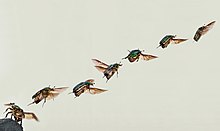
Back Beweging Afrikaans Bewegung (Physik) ALS حركة (فيزياء) Arabic حاراكة (فيزيك) ARY গতি Assamese Movimientu AST Mexaniki hərəkət Azerbaijani حرکت AZB Paghiro BCL Механічны рух Byelorussian

Movement, or motion, is the state of changing something's position or changing where something is. A bird that is flying is moving. So is a person who is walking. This is, because they change where they are. They "move" from one place to another. There are many forms of science and mathematics that are related to movement.
Because of the work of scientists including Galilei and Newton, we know that position is relative. This means that an object's position depends on where it exists in relation to other objects. For example, a ball can be 5 ft (150 cm) away from a box, 3 ft (91 cm) from a chair and 1 ft (30 cm)away from a table. Here, the box, chair and the table helped to define the position of the ball. They acted as the reference points for the observation of the ball. By telling someone how far the ball was from other objects, they were told its relative position.
The motion of an object is also relative. It depends on how its position changes in relation to other objects. For example:
A person is sitting inside a train (Train A). The train has not started moving yet. When that person looks out the window, they see another train (Train B) . Both trains are facing the same direction. If Train B moves backwards, it appears to the person on Train A that they are moving toward Train B. If a reference point it added this can be changed. If the person can also see a pole next to the trains they will see that train A did not move and train B moved backwards.
From this, it is shown that what the movement is can not be known without a frame of reference. In this example the pole is the frame of reference.
The study of motion without considering its cause is called kinematics. Kinematics deals with terms like speed, velocity, and acceleration. Dynamics is the branch of physics that focuses on the causes and effects of motion. It deals with force, inertia, work, energy and momentum.
© MMXXIII Rich X Search. We shall prevail. All rights reserved. Rich X Search